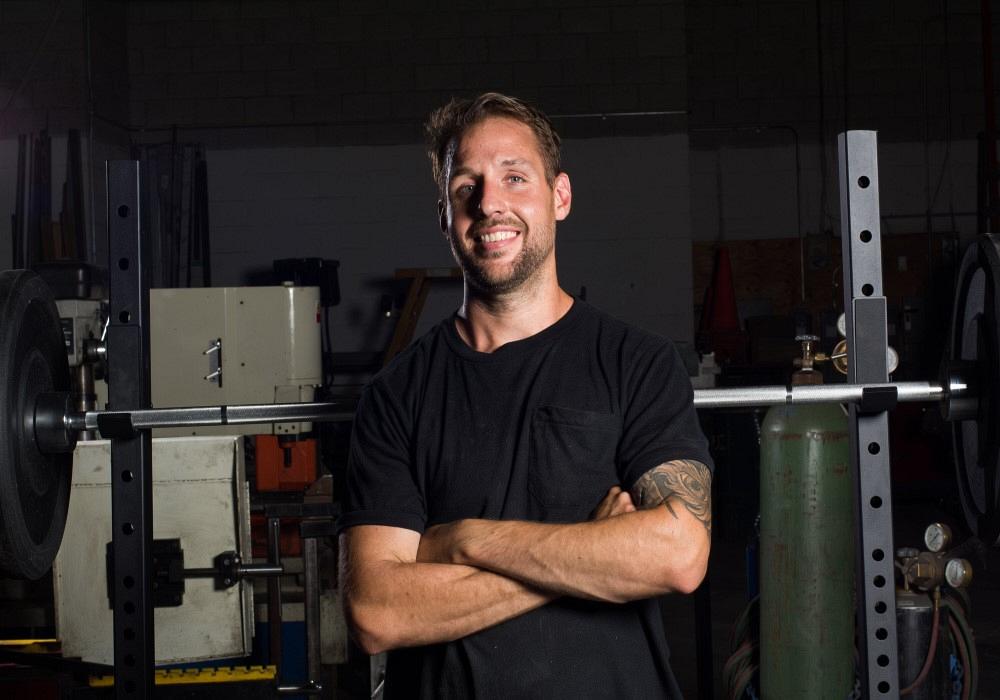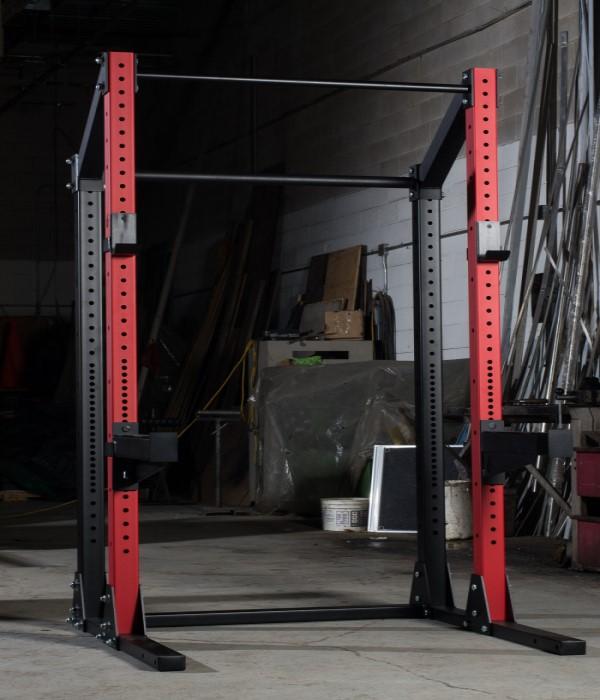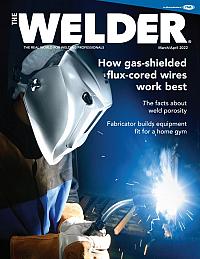- FMA
- The Fabricator
- FABTECH
- Canadian Metalworking
Categories
- Additive Manufacturing
- Aluminum Welding
- Arc Welding
- Assembly and Joining
- Automation and Robotics
- Bending and Forming
- Consumables
- Cutting and Weld Prep
- Electric Vehicles
- En Español
- Finishing
- Hydroforming
- Laser Cutting
- Laser Welding
- Machining
- Manufacturing Software
- Materials Handling
- Metals/Materials
- Oxyfuel Cutting
- Plasma Cutting
- Power Tools
- Punching and Other Holemaking
- Roll Forming
- Safety
- Sawing
- Shearing
- Shop Management
- Testing and Measuring
- Tube and Pipe Fabrication
- Tube and Pipe Production
- Waterjet Cutting
Industry Directory
Webcasts
Podcasts
FAB 40
Advertise
Subscribe
Account Login
Search
Homemade squat rack sparks business designing, fabricating workout equipment
Canadian welder/fabricator made home workouts easier during COVID-19 shutdowns
- By Amanda Carlson
- Updated March 22, 2022
- March 18, 2022
- Article
- Arc Welding

Mike Kaufmann of Vaughan, Ont., knew there were plenty of ways to work out at home when all the gyms closed because of COVID-19. One thing he couldn’t do at home was lift with the help of a squat rack. So the welder/fabricator decided to build his own.
When gyms and workout facilities were required to shut down during the early days of the COVID-19 pandemic, avid fitness buffs were left to figure out creative ways to get their workouts in at home.
Mike Kaufmann of Vaughan, Ont., went well beyond most people’s definition of creative. Lifting and working out was a normal part of his daily routine. As a lifelong athlete, he knew there were plenty of ways to work out at home, but one thing he couldn't do at home was lift using a squat rack. And then he got an idea. Why not build his own squat rack?
After all, he’s a CWB-certified welder and fabricator, so how hard could it be? Plus, he had a ton of time on his hands since his employer, Concise Custom Metal, was temporarily shut down because it did mostly commercial work and was deemed nonessential by the Canadian government.
Nearly two years later that one-off squat rack has turned into a side business, Squat6stands, which has sold 500 units. His squat rack is sturdy enough to securely hold a barbell and weight but compact enough to fit inside someone’s home. He’s even expanded his product offerings to include adjustable benches, pull-up bars, and spotter arms.
Kaufmann spoke to The WELDER recently about his business and what he’s learned along the way.
How did Squat6stands begin?
I've been playing rugby most of my life, and I’ve spent a lot of time in the gym. When all the gyms closed due to the pandemic, I needed a squat rack for myself. I was learning AutoCAD at the time, so I just took to the drawing board.
When I look at a squat rack, I know the uprights are made of either 2 by 2 or 3 by 2 11-ga. steel. If you’re using a 7-ft. barbell, you have a base that is 4 ft. wide. These dimensions are typical no matter who is making the rack. I wanted the height of the uprights to be able to fit in someone’s basement. Most people have 96-in. basements, so the top of the upright is 88 in. to give them about 8 in. of clearance.
Once it was finished my wife loved it. We ended up just putting it on Facebook Marketplace and Kajiji and from there the orders started coming in.
What are some design improvements you’ve made since building your first squat rack?

Nearly two years later that one-off squat rack has turned into a side business, Squat6stands, which has sold 500 units in two years. His squat rack is sturdy enough to securely hold a barbell and weight but compact enough to fit inside someone’s home.
I started with something typical, but being into structural steel and all that stuff, I wanted it to look a little bit more robust, so I upgraded the hardware. My J-clips, which is where the barbell rests, had no protection; it was just steel on steel. So, I put a UHMW, which is basically high-density plastic, all around the J-clip to protect the upright from scratching.
How long did it take for business to take off?
It grew quickly. The best part is that we grew mostly from word-of-mouth. Someone bought a rack and then referred us to a friend, and so on. As orders came in, I got to work and now we’re at the point where we’ve sold about 500 units so far.
How have your customers reacted to the product?
People are loving it. When they come and pick it up, they can feel how heavy duty it is. It’s not a flimsy squat rack. Everything is solid, and the powder coating is really nice.
I’m just really proud to put out a quality Canadian product. We are really lacking in fitness equipment manufacturers here. There’s a bunch of amazing ones in the states, but no one is really doing it here in Canada.
Did you have any help once customer demand ramped up?
When I first got started, I was drilling everything by hand. I made a jig, and I was going through drilling some pilot holes and opening those holes up. It took me between six to eight hours to build one rack. As more orders came in, I started getting all my tube laser-cut. I had the uprights with all the holes laser-cut, and then I would produce the rest of the parts. I just tried to streamline things as much as possible. My wife handled all the social media and built the website, and she killed it. And then I have a friend that comes in on weekends to help me pack orders and do some busy work.
Did you have to deal with any unexpected challenges?
Absolutely. It’s not something I could have been told ahead of time; it was something I needed to experience to learn. As far as tolerances go, not all HSS (hollow structural section) tubing is the same, so I needed to cater to everything working around that tubing to make sure we met those tolerances. I’m a welder and a fabricator, but when I first got started, I didn’t know anything about metal fabrication involving laser cutting, brake forming, and that sort of thing. That was a huge curve ball for me. But I’m a firm believer that these experiences have shaped me and helped round out my career. I have made a few mistakes, but it has made me grow as a fabricator.
Now that you’re back to work at your regular job, how do you balance your time between doing that and working on Squat6stands?
I work a lot of nights and a lot of weekends. But I’ve been able to streamline things and build in bigger batches, so I have things in stock. I’m still able to do modifications if someone needs a custom height or that type of thing.
What’s something you’ve taken away from this entire experience?
I haven’t worked a day over the past two years, which is crazy to say because I’ve actually worked every day. I’ll go to work and before I know it, 13 or 14 hours have gone by. I truly love what I’m doing. The fact that what I’m building is gym equipment is just the cherry on top of the cake for me.
I’ve had some guys reach out to me who are in welding school right now, and they tell me that what I’m doing is awesome. We’ll talk, I’ll give them a few tips and tricks, and it’s great. I would love to see more people out there choosing to be a welder and metal fabricator.
About the Author

Amanda Carlson
2135 Point Blvd
Elgin, IL 60123
815-227-8260
Amanda Carlson was named as the editor for The WELDER in January 2017. She is responsible for coordinating and writing or editing all of the magazine’s editorial content. Before joining The WELDER, Amanda was a news editor for two years, coordinating and editing all product and industry news items for several publications and thefabricator.com.
About the Publication
subscribe now

The Welder, formerly known as Practical Welding Today, is a showcase of the real people who make the products we use and work with every day. This magazine has served the welding community in North America well for more than 20 years.
start your free subscription- Stay connected from anywhere

Easily access valuable industry resources now with full access to the digital edition of The Fabricator.

Easily access valuable industry resources now with full access to the digital edition of The Welder.

Easily access valuable industry resources now with full access to the digital edition of The Tube and Pipe Journal.
- Podcasting
- Podcast:
- The Fabricator Podcast
- Published:
- 04/16/2024
- Running Time:
- 63:29
In this episode of The Fabricator Podcast, Caleb Chamberlain, co-founder and CEO of OSH Cut, discusses his company’s...
- Trending Articles
Sheffield Forgemasters makes global leap in welding technology

Welding student from Utah to represent the U.S. at WorldSkills 2024

Lincoln Electric announces executive appointments

Lincoln Electric acquires RedViking

Engine-driven welding machines include integrated air compressors

- Industry Events
16th Annual Safety Conference
- April 30 - May 1, 2024
- Elgin,
Pipe and Tube Conference
- May 21 - 22, 2024
- Omaha, NE
World-Class Roll Forming Workshop
- June 5 - 6, 2024
- Louisville, KY
Advanced Laser Application Workshop
- June 25 - 27, 2024
- Novi, MI


























